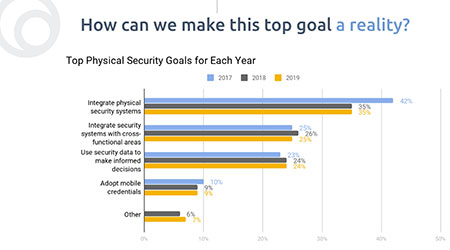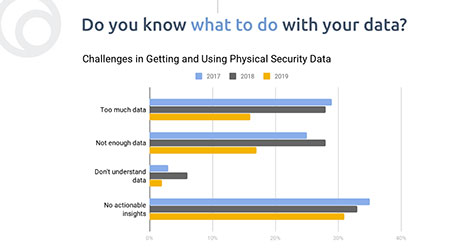SPONSORED
Brivo - Branded Feature
2020 Vision for Physical Security: Where are we Headed?
It's 2020 - the beginning of a new decade. It's a time to take stock of what is and isn't working and to accept new challenges and look to the future to achieve new goals.
Step 1: Start with the Data
In an effort to start at the beginning, a "take stock" effort went underway in December of 2019 to understand the main physical security challenges and goals of security professionals. Brivo and Security Management Magazine partnered on a survey that received over 500 responses from Security Managers and Directors.
Here's what security leaders had to say about their challenges and goals:
The Challenges:
Security breaches and compliance are the top two physical security challenges with 48% and 44% of the vote, respectively. These have been the top challenges for the past three years, but 2020 is the year to take action. Organizations cannot run efficiently or safely when security breaches happen and they are out of compliance. The technology exists today to significantly curb these occurrences. Are you taking advantage of that technology? If not, what are you waiting for?
The Goals:
Highlighted in our yearly market research, the challenges for security professionals have remained consistent over the years, and so have your goals. New technology means new capabilities, more convenience, and improved efficiencies for your organization. The survey outlined security goals for 2020 that have the ability to take your strategy to a new level.
The top rated 2020 goal for survey participants was to integrate physical security systems with other cross-functional areas within the organization including HR software, management apps, and other PropTech. Make 2020 the year you make these goals a reality at your organization.

More than ever, security professionals are looking to bring the technology they use around the business together. This is a trend we see everywhere in business today. The reason for this need lies in the added security that comes from integrated systems and the collection and collation of data that contributes to better visibility into operations. Disconnected systems require redundant information. This leaves room for human error.
Security leaders also want to use physical security data to make informed decisions and 80% of respondents say they look at physical security data, but 67% said they cannot use their data effectively to make an impact.

Access to useful data is critical to understanding the rate of technology adoption as well as ongoing and new technology needs. Knowing how to collect, manage and use data will be an important trend into 2020 and an area to invest in the future.
Step 2: Address the Challenges and Meet the Goals
The Challenges:
Security breaches and compliance
The best way to solve for challenges like breaches and compliance is to use technology that was built to solve current and future physical and cybersecurity needs. Solutions like implementing cloud-based access control are the best way to deliver that balance of control and improved compliance to deflect and eliminate breaches.
A recent Gartner study showed there is a growing desire for Security as a Service: there is a $116 Billion global market size in 2020 for Software as a Service (SaaS) and a $50 Billion global market size for cloud system infrastructure services. The growth of SaaS and cloud system infrastructure services means these solutions are the future of our industry.
Survey participants also selected their top three benefits of a cloud-based platform, which are cost savings, convenience, and scalability. The benefit of cost savings relates to system and staff efficiency, as well as fewer actual hardware costs from servers.
As you evaluate physical security solutions for your future needs, you need to know that your physical security provider is cyber secure in how they build products, deploy applications and manage their internal teams to keep the system secure. That means there are practices in place to consistently update and test the platform to find vulnerable areas and protect against hacks. Make sure you evaluate cloud-based access control platforms for their commitment to being cyber secure, that way you will know you have the right technology to transform your business.
Find the right provider for your needs - investments are growing and providers are expanding the solutions available to you.
The Goals:
Integrated physical security systems
To reach your organization's goal to improve system integration, you need to start by bringing your disparate security systems together. Only 35% of the security leaders surveyed said they have a centralized physical security system. Switching to a centralized security platform with a customizable API ecosystem will drive higher efficiency and security.
Once a centralized system is in place, you can extend your unified security platform to integrate with other important functions like Identity and Access Management Solutions (for example: Okta, Azure, and G Suite) to ensure you grant the right levels of access. And that isn't just about reaching higher business efficiency, that is about providing protection for your physical space, software and business assets.
Centralized security is better security with less work. Having too many systems leads to data loss, bottlenecks, and errors. Experian conducted a survey that found human error is the leading cause of data inaccuracy that affects systems like physical security platforms. This could put you at severe risk.
Too many disparate systems is not only dangerous but also requires data to be updated everywhere. Bring disparate systems together to eliminate duplicative data entry, improve compliance and create a competitive advantage at your organization.
Security leaders want to use physical security data to make informed decisions
The Brivo survey proves that most security teams are looking at physical security data. Over, 80% of respondents said they have data but, 67% indicated they cannot use it effectively to support policy compliance, understand building access trends, investigate suspicious behavior patterns or make an overall improvement to security policies and procedures.
Security platforms have to deliver actionable, understandable, and accurate data. If not, then overall security falls short.
Security professionals want the benefits of data to improve security policies and investigate suspicious behavior. These were the top two needs that respondents want to gain from physical security data. Ironically, data also helps to solve the top overall physical security challenges: compliance and security breaches.
Data is a must. An IHS Markit study shows that the number of connected devices increased from 15.4 billion in 2015 to 30.7 billion in 2020 and is projected to hit 65.4 billion by 2025. Each of these millions of devices creates data at enormous speeds and increases access points exponentially.
The connectivity of every component means more data that can lead to insights. When you implement a cloud-based security platform that integrates across systems, you can harness the power of all that data, manage it, and access robust data analytics to transform your security operation.
Step 3: Implement and Prepare for the Future
Physical security professionals can transform organizations with secure technology, integrated systems, and security data.
The future of security encompasses both physical security and cybersecurity. To have a truly secure organization, both fronts must be protected from threats. Any physical security platform you choose must also be cybersecure. The benefits of the right cloud-based platforms are that consistent testing and updates are made to ensure the technology is cyber hardened.
Digital transformation for your security organization means that you are ready for the integration needs of the future. In a statistic from IHS Markit mentioned above, the number of connected devices is projected to hit 65.4 billion by 2025. More connected devices will mean a more aggressive demand for connected systems. Plan for that now. The physical security platform you choose today must be able to stand the test of time.
Right now, the physical security platforms in use are falling short on the data front. Choose a platform that can provide data and analytics that are robust, flexible and can tell a larger story about how people access and use your facilities.
This is an exciting time in the physical security industry - 2020 is the year to take action. Are there inefficiencies in your physical security solution? Leverage secure technology, integrated systems, and security data to make this the most secure, convenient, and efficient year to date.
Watch the on-demand webinar, "2020 Vision for Physical Security: 3 Initiatives to Set Your Sights On", to learn more about the results of the Brivo and Security Management Magazine survey on the state of Physical Security in 2020.










